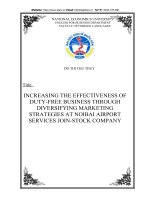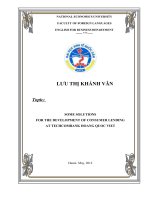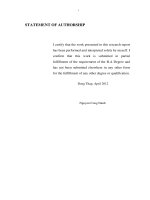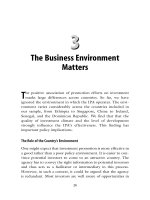ENHANCING THE EFFECTIVENESS OF SHORTTERM LENDING AT VIETINBANK THANG LONG BRANCH
Bạn đang xem bản rút gọn của tài liệu. Xem và tải ngay bản đầy đủ của tài liệu tại đây (467.04 KB, 90 trang )
STATE BANK OF VIETNAM
BANKING ACADEMY
FACULTY OF FOREIGN LANGUAGES
--------
GRADUATION THESIS
ENHANCING THE EFFECTIVENESS OF SHORT-TERM
LENDING AT VIETINBANK - THANG LONG BRANCH
Hanoi, May 2019
ACKNOWLEDGEMENTS
First of all, from the bottom of my heart, I would like to convey my
most sincere thanks to my beloved instructor as well as my mentor,
Mr. Ngo Tung Anh (MA, MBA), Faculty of Foreign Languages – Banking
Academy, for his great inspiration, constant guidance and valuable
support during my thesis writing process. Without his whole-hearted
instruction, I could not have completed this thesis.
Secondly, I would also like to express my great attitude toward Ms.
Le Thi Thien Ly, the director of VietinBank – Thang Long Branch and
all staff in Corporate Banking Department, who enthusiastically
offered me with the very first ideas on research methods, dedicated
guidance and encouraged me during my internship process. I have
learned a lot of professional knowledge and credit experience of my
internship assistance. Thanks to his great assistance, I have finished
my thesis. Additionally, I also owe my deepest gratitude toward all
teachers at Banking Academy, especially those of the Faculty of
Foreign
Languages
for
helping
me
to
cultivate
background
knowledge of subjects related to my thesis.
Finally, I would like to give the last grateful sentence to my beloved
family and precious friends who always stand by me and constantly
encourage me during four years at Banking Academy. They are really
the tremendous spiritual motivation for me to make my best efforts
to overcome the most difficult time as a student at my university.
Because of time constraints and limited experience, the thesis might
have many shortcomings. Therefore, it is my hope that lecturers and
readers of the thesis will sympathize and give valuable comment to
make it better.
1
DECLARATION
I hereby declare that this thesis is the product of my own work
towards the Bachelor in English at Banking Academy and that to the
best of my knowledge, it contains no material previously published
by another person. All the sources I have used have been indicated
and acknowledged by means of complete references.
Hanoi,
20th May, 2019
Signature
Tran Duc
Huong
2
TABLE OF CONTENTS
ACKNOWLEDGEMENTS.....................................................................i
DECLARATION...................................................................................ii
ABSTRACT.........................................................................................iv
LIST OF ABBREVIATIONS.................................................................v
LIST OF FIGURES.............................................................................vi
LIST OF TABLES..............................................................................vii
CHAPTER 1: INTRODUCTION..........................................................1
1.1. Rationale to the research.........................................................1
1.2. Objectives of the study............................................................1
1.3. Research questions..................................................................2
1.4. Scope of the study....................................................................2
1.5. Methodology of the study.........................................................2
1.6. Structural organization of the thesis........................................2
CHAPTER 2: REVIEW OF RELATED LITERATURE..........................4
2.1. Theoretical and conceptual framework.......................................4
2.1.1. Overview of short-term lending operations of commercial
banks.............................................................................................4
2.1.2. Quality of short-term lending activities at CBs....................7
2.1.3. Factors affecting short-term lending operations at
commercial banks........................................................................12
3
2.2. Overview of VietinBank Thang Long branch............................16
2.2.1. Brief history of establishment and development...............16
2.2.2. Organization structure.......................................................17
2.2.3. Operation fields.................................................................17
2.3. Some general provisions in short-term loans at VietinBank
Thang Long branch19
2.3.1. Short-term loan process at VietinBank Thang Long branch
.....................................................................................................19
2.3.2. Short-term loan products at VietinBank Thang Long branch
.....................................................................................................22
2.4. Research projects related to the topic.....................................24
2.5. New points in the thesis..........................................................27
2.6. Sub-conclusion........................................................................28
CHAPTER 3. RESEARCH METHODOLODY....................................29
3.1. Locale of the study..................................................................29
3.2. Research design/ research instruments..................................29
3.3. Data gathering procedures......................................................30
3.4. Statistical treatment................................................................30
3.5. Sub-conclusion........................................................................31
CHAPTER 4: RESULTS AND DISCUSSION....................................32
4.1. Results.....................................................................................32
4.1.1. Current status of short-term lending operations at
VietinBank Thang Long branch....................................................32
4.1.2. Business performance of VietinBank Thang Long branch
from 2016 to 2018.......................................................................39
4.2. Discussions..............................................................................45
4.2.1. Evaluating the status of short-term loan performance at
VietinBank Thang Long branch from 2016 to 2018.....................45
4.2.2. General assessment of short-term lending performance at
VietinBank Thang Long branch....................................................54
4.3. Sub-conclusion........................................................................59
CHAPTER
5:
SUMMARY,
FINDINGS,
CONCLUSION
AND
RECOMMENDATION.........................................................................60
4
5.1. Summary.................................................................................60
5.2. Findings...................................................................................60
5.3. Conclusion...............................................................................61
5.4. Recommendations...................................................................62
5.4.1. Development orientations of VietinBank Thang Long branch
.....................................................................................................62
5.4.2. Strategies for enhancing short-term operations at
VietinBank Thang Long branch....................................................62
5.4.3. General recommendations................................................65
REFERENCES...................................................................................68
ABSTRACT
Title:
Enhancing
the
effectiveness
of
short-term
lending
at
Vietinbank Thang Long branch
Author: Tran Duc Huong, last-year student of Foreign Languages
Faculty, Banking Academy
Key Words: Short-term lending, Vietinbank Thang Long branch,
Vietnam’s commercial banks, the effectiveness.
Advisor: Mr. Ngo Tung Anh (MA, MBA) the Vice-Dean of Foreign
Languages Faculty, Banking Academy
Abstract:
The purpose of thesis aims at analyzing and evaluating the status of
short-term lending activities at Vietinbank Thang Long branch. The
thesis has analyzed about the quality of short-term lending in
Vietnam’s commercial banks, which led to factors affecting this
5
lending activity. The study has been conducted by the quantitative
method through data collection methods at Vietinbank Thang Long
branch. Methods of qualitative, comparatives, and descriptive
statistics have used in the study. With the results of the study, the
research has provided information on factors affecting short-term
lending at the branch. Besides, the author has given achievements
and limitations in this lending activity of the branch. Finally, through
this research, the author has presented solutions based on direct
analysis of factors affecting short-term lending activities and given
development directions to the branch, from there helping the
branch's board of directors have solutions to improve short-term
lending activities in the future.
LIST OF ABBREVIATIONS
SBV
The State Bank of Vietnam
VietinBank
Vietnam
Agribank
Industry and Trade
Vietnam Bank for
BIDV
Development
Bank for Investment
CBs
Vietnam
Commercial banks
VND
SMEs
D/P
Vietnam dong
Small and Medium Enterprises
Documents Against Payment
Joint
6
Stock
Commercial
Agriculture
and
Bank
and
for
Rural
Development
of
D/A
Documents Against Acceptance
ATM
Automated Teller Machine
NPL
Non-performing Loan
SMEDF
Small and Medium Enterprise Development Fund
LIST OF FIGURES
Figure 2.1. Organizational structure of VietinBank Thang Long branch
..........................................................................................................17
Figure 2.2. Short-term credit granting procedures of VietinBank
Thang Long branch...........................................................................19
Figure 4.1. Total short-term outstanding loans in the period of 20162018..................................................................................................39
LIST OF TABLES
Table 4.1. Total loan sales by term at VietinBank Thang Long branch
from 2016 to 2018............................................................................33
Table 4.2. The classification of short-term loan sales by economic
sectors from 2016 to 2018................................................................34
7
Table 4.3. Total debt collection revenue at VietinBank Thang Long
branch from 2016 to 2018................................................................36
Table 4.4. The classification of short-term debt collection by
economic sectors from 2016 to 2018...............................................37
Table 4.5. Total mobilized capital in the period 2016-2018...............40
Table 4.6. Capital utilization in the period 2016-2018......................43
Table 4.7. Business results of VietinBank Thang Long branch during
the period between 2016 and 2018..................................................45
Table 4.8. Total short-term outstanding loan on total mobilized capital
in the period of 2016-2018...............................................................49
Table 4.9. Total short-term outstanding loan on total short-term
mobilized capital in the period of 2016-2018...................................50
Table 4.10. The structure of debt groups at VietinBank Thang Long
branch from 2016 to 2018................................................................51
Table 4 11. The situation of overdue debt from 2016 to 2018..........53
Table 4.12. The ratio of short-term debt collection from 2016 to 2018
..........................................................................................................54
8
CHAPTER 1: INTRODUCTION
1.1. Rationale to the research
Currently, the economic development is the spearhead of many
countries
in
the
world,
including
Vietnam.
The
economic
organizations of Vietnam are also growing constantly, especially the
changes in both the quality and quantity of the banking system.
Along with other economic sectors, the bank is tasked with
participating in stabilizing the monetary market price, seeking and
repelling inflation, creating jobs for workers, helping investors and
developers, supporting capital market and foreign exchange market,
participating and supporting payment.
Short-term lending is one of the most important business activity in
the credit operations of all commercial banks. The number of
businesses,
consumer
demand,
and
procurement
services
of
individual or organizations in the city are always high, so the
demand for a short-term loan is very large. Many banks are trying to
provide the best service to meet this need of society.
As a commercial bank with capital potential, Vietinbank Thang Long
branch has paid great attention to short-term lending activities in
recent years. However, due to the difficult economic situation and
fierce competition among banks in short-term lending, the branch
still faces some limitations. Therefore, it is necessary to promote the
effectiveness of short-term lending.
Through the research and study of lending activities with the
guidance of Master Ngo Tung Anh, the author has decided to choose
the title: "Enhancing the effectiveness of short-term lending
operation at VietinBank - Thang Long Branch" as my thesis topic.
Based on the results of the research and analysis of collected data,
the thesis proposes a number of suggestions to promote the
1
effectiveness
of
short-term
lending
at
Vietnam
Joint
Stock
Commercial Bank for Industry and Trade - Thang Long Branch.
1.2. Objectives of the study
- Studying basic theoretical issues about short-term lending
activities, determining the necessity of promoting lending
-
activities of commercial banks in Vietnam.
Researching the status of short-term loan performance at
Vietnam Joint Stock Commercial Bank for Industry and Trade Thang Long branch from 2016 to 2018 from which the author
-
gives the strengths, limitations and causes of such restrictions.
Proposing some solutions to boost the effectiveness of shortterm lending activities at Vietnam Joint Stock Commercial Bank
for Industry and Trade - Thang Long Branch.
1.3. Research questions
The thesis has been designed to analyze the reality of short-term
lending at Vietinbank Thang Long branch. To be extra specific, the
study seeks answers to these following questions:
a) Which criteria should be chosen to assess the quality of the
short-term lending activities?
b) Which factors have influence on the quality of the short-term
lending activities?
c) How efficiently did Vietinbank Thang Long branch perform its
short-term lending operations during the period between 2016
and 2018?
d) What can be the solutions for Vietinbank Thang Long branch to
perfect itself?
1.4. Scope of the study
- Object of the thesis study: Lending activities performance at
VietinBank Thang Long branch from 2016 to 2018
2
-
Scope of the thesis research: The reality of short-term loan
performance at Vietnam Joint Stock Commercial Bank for
Industry and Trade - Thang Long Branch from 2016 to 2018.
1.5. Methodology of the study
Graduation thesis has used some scientific research methods to
analyze practical theory: data comparison method, dialectical
materialism method, historical materialism method, method of
analyzing economic activities, statistical synthesis method.
1.6. Structural organization of the thesis
Graduation thesis is divided into five chapters as follows:
CHAPTER 1: INTRODUCTION
CHAPTER 2: REVIEW OF RELATED LITERATURE
CHAPTER 3: RESEARCH METHODOLODY
CHAPTER 4: RESULTS AND DISCUSSION
CHAPTER 5: SUMMARY, FINDINGS, CONCLUSION AND
RECOMMENDATION
3
CHAPTER 2: REVIEW OF RELATED LITERATURE
2.1. Theoretical and conceptual framework
2.1.1. Overview of short-term lending operations of commercial
banks
a)
Definition of short-term lending operations of commercial
banks
According to Law on Credit Institutions, 2010: “Short-term credit is a
loan with a term of less than one year. Commercial banks are
suppliers of most short-term loans to businesses. These loans have a
low risk of solvency as well as interest rate compared to medium and
long-term loans. Short-term loans are often widely used in the
financing of working capital and production costs”.
b)
Features of short-term lending operations of commercial banks
Short-term loan is mainly to meet the temporary shortage demand
for working capital in the production and business process of
enterprises. Banks often lend when customers need capital to buy
supplies, materials, or cover production costs. When goods are
consumed, customers have income. It is the time when the bank
recovers debts. Stemming from this characteristic, banks often set a
4
lending period based on the borrower's production cycle. Therefore,
the payback period in short-term loans is faster than medium and
long-term loans.
The payback period is quick so the risk of short-term loans is lower
than medium and long-term loans and leading to lower the interest
rate of short-term lending than that of a medium and long-term loan.
Therefore, short-term loan is less affected by the unpredictable
fluctuations of the economy such as medium and long-term loan. In
addition, short-term loan is provided to production and business
units in the form of discounted valuable papers, based on collateral,
guarantee and trade finance. The bank will surely have a future
compensation, so the risk of bringing it is often low.
Short-term
lending
is
the
main
activity
of
the
bank.
The
characteristic of the bank is business in the monetary field, in which
receiving deposits and making loans. Therefore, with the interest
rate and timing, banks mainly offer short-term loans to customers.
Because the risk of the loan is often not high, the interest rate for
borrowers is often low. Short-term credit that banks provide to
customers is often used by customers to buy materials, pay salaries,
and supplement working capital so the capital loan is often small.
Banks give increasingly diversified types of short-term loans such as
line credit loans, credit limit loans, overdraft loans, and capital
transfer loans to meet the diverse needs of customers, risk
distribution and to enhance competitiveness in the credit market.
That has made various forms of short-term loan which is very rich
such as advance, overdraft and discounting operations.
c)
Classification of short-term lending operations of commercial
banks
5
The bank provides short-term loans to meet the demand for capital
for production and business services for customers. Hence, shortterm loans are divided into many different types of loans, but in
terms of loan usage purposes, short-term loans include business
customer loan and individual customer loan.
Lending to corporate customers
Lending to corporate customers are a form of the bank financing
economic capital for businesses. Lending forms are considered
according to the nature of funding, including two main types:
additional working capital loan and secured assets loan.
-
Additional working capital loan to finance a working capital for
production
and
business
activities
of
customers.
When
borrowing money, borrowers use their own income from using
loans to repay debt for the bank, so the important factors that
the bank focuses on are the business ability, financial situation,
and effectively using customer loans.
-
Lending on collateral is primarily a form of lending on export
documents based on the value of receivables from customers.
In the form of a letter of credit or collection, this type of grant
allows exporters to receive most of the money collected from
the paying bank or foreign importer after sending the
documents for collection.
Lending to individual customers
Individual customer lending is a form of loan whereby the bank
assigns the customer an amount of money to use for a certain
purpose and time as agreed with the principle of repayment both
principal and interest.
6
Personal loans to discuss major needs include: serving life and
consumption, supplementing capital for trading and production of
individual households. This form is divided into two categories:
-
Consumer loan: this is a form of financing for personal and
household expenditure. Consumer loan is an important source
of financing capital for customers to cover their life needs such
as housing, transportation, and construction.
-
Industrial and commercial loan: this is a form of financing for
the
purpose
of
supplementing
transportation
or
construction
capital
facilities
and
of
purchasing
individuals
in
business and trading.
d)
-
Purpose of short-term lending operations of commercial banks
Short-term loan helps supplement working capital and creates
conditions for businesses to expand production and business
activities.
The bank as a financial intermediary performs one of its main
functions, is to mobilize temporarily idle capital sources and then use
that capital to supply the economy. Through its lending activities, the
bank has ensured that domestic enterprises not only keep up
production and business but also expand their production.
-
Short-term credit helps businesses enhance management and
use of working capital effectively
The nature of short-term credit is not only a form of capital supply
but also a return of both principal and interest after a specified
period. Therefore, enterprises after using loan capital in production
and business not only need to recover capital to be enough but also
have to find many measures to use capital effectively, economically,
quickly to increase the capital turnover. To make sure that the profit
7
margin is higher than the bank interest rate, so enterprises can pay
their debts and interest.
-
Short-term credit positively affects development pace and
promotes competition
In the context of the market economy, the activities of enterprises
are strongly influenced by objective economic laws such as the rule
of value, the law of supply and demand, and the rules of
competition. Besides, production and business must be based on
meeting the market demand and satisfied in all aspects. The
operations of enterprises must achieve certain economic efficiency
according to the general regulations of the market and make sure to
stand firm in the competitive market. In order to meet the
requirements of the market, businesses need not only to improve the
quality of labor, consolidate and improve the economic management
mechanism and accounting regime but also constantly improve
advancing machinery and technology lines, explore new materials,
and expand production scale appropriately. These activities need a
large amount of investment capital while the equity of the enterprise
is not able to meet these requirements. To be able to solve these
difficulties, enterprises can apply the bank loans to meet their
investment needs. Through credit and banking activities as a bridge
to connect businesses to the market, short-term credit has played an
important role in improving the manufacturing process, helped
businesses meet market demand, and kept up with the general
development
pace,
thereby
creating
a
firm
foothold
in
the
competitive environment.
2.1.2. Quality of short-term lending activities at CBs
a)
The need to boost the efficiency of short-term lending at
commercial banks
8
To the economy
Any country that wants to develop the economy needs to have a
large investment capital to innovate technology, increase labor
productivity, reduce production costs, and increase competitiveness.
But to have such a large amount of investment, only credit relations
can meet that requirement. The bank in this case as a financial
intermediary is the channel that transfers capital from the capital
surplus to the capital shortage and increases the efficiency of
business activities in the economy. The bank's lending activities have
increased the income of savers while reducing the cost of credit
capital for investors, thereby encouraging investment to increase
productivity labor for the economy.
To the commercial bank
Short-term lending is one of the important activities of commercial
banks, which is a major source of income for banks and has a
significant impact on the other activities of banks. Promoting shortterm lending not only helps the bank make profits, reduce
operational and management costs but also especially reduce huge
losses due to the failure to recover long-term loans. Thus, this
activity will increase the profitability from products and services that
banks give to customers and increase large profits for the
commercial banking system.
In addition, through the promotion of short-term lending activities of
banks, this helps banks develop sustainably, strengthen relationships
with traditional customers, expand and attract more customers. It is
also a way for commercial banks to expand market share and
improve profits.
To the customer
9
Bank customers include 2 types: Depositors and borrowers
The depositors are interested in the bank's solvency while the bank's
ability to make payments has a close relationship with loan
effectiveness. Therefore, boosting lending is a necessary issue
because it directly affects customer deposits in the bank.
The borrower is the person who directly uses the loan from the bank.
In order to ensure the effectiveness of the loan, the bank needs to
conduct checking and controlling the loan usage and coordinating
with customers to timely adjust the shortcomings in financial and
business activities, thus generating revenue for customers to cover
costs and interest. Borrowers must consider the effectiveness of the
loan as a necessary issue for themselves.
b)
Criteria in measuring short-term lending quality
Qualitative criteria
This is a group of indicators to assess the effectiveness of loans on a
legal basis in compliance with regulations and professional processes
and implementation in accordance with commitments on loan
contracts.
-
On the legal basis: The effective lending activities must abide
by the highest laws of the State, including the Constitutional
law and the Law on Credit Institutions, lending regulations, key
documents of the Government and the SBV.
-
Loan policies: The effective lending activities must be always
complied with the rules and procedures for its operations. From
its own characteristics, most banks research and provide the
most suitable lending regulations. In particular, banks set up a
Credit Handbook that outlines specific concepts, regulations,
processes, and guidelines for bank officials. The bank priory
10
provides a credit to good customers and restrictively gives a
credit to customers in potentially risky areas. Therefore,
compliance with processes is the premise of loan efficiency.
-
On the basis of loan contracts: In the loan contract, details of
important factors such as loan term, purpose of use, loan limit,
debt repayment method, interest payment, etc., are expressed
in the form of commitments. A loan is considerably effective
when it is properly implemented with the commitments that
signed in the credit contract. If customers do not comply with
the terms of the contract, the loan will be considered to have a
risk. Moreover, a loan that is not repaid on time, customers
have overdue repayments many times, the loan is not
considered to be effective.
-
Internal control: Lending activities in banks are very sensitive
and face many risks. Therefore, internal control is established
with specific mechanisms, policies, processes and regulations
to help identify, evaluate regularly and prevent risk in lending
activities, thereby proposing appropriate risk management
measures and improving the lending quality. In order to do this
well, the bank needs to have the professional, objective and
honest officials to provide strict penalties. Since then, lending
activities have been able to ensure proper implementation of
the required process to improve the effectiveness of the loan.
-
Credit risk management strategies: Credit risk management is
the process of accessing risks in a scientific, comprehensive
and systematic way to identify, control, prevent, minimize
losses, and adverse effects of risk. Credit risk management
activities are often focused on customers' compliance with the
loan purpose, business performance of the business, collateral,
11
and repayment process. Risk management activities include
monitoring, reviewing, studying the operating environment of
the bank in order to list all risks, customer ratings, loan
security, and risk provision. This administration not only covers
the types of risks that have been occurring but also predicts
new types of risks that may occur to the bank, from which
measures to control each type of risks accordingly.
The groups of qualitative criteria above may reflect a part of the loan
quality.
In
order
to
consider
specifically,
carefully
and
comprehensively, it is necessary to consider criteria such as credit
policy, bad debt handling, moral hazard, and management level.
Quantitative criteria
-
The indicator of short-term outstanding loans on total capital
The ratio of short-term debt balance on total capital =
This index helps compare the short-term lending ability of banks with
the ability to raise capital and determine the structure of short-term
loans. Based on this criterion, they compare over the years to assess
the concentration of bank credit.
-
The indicator of short-term outstanding loans on total shortterm mobilized capital.
The ratio of short-term debt balance on total short-term capital =
This indicator is very important to assess the efficiency of the bank's
capital use, whether the bank has used all its capabilities in shortterm lending or not? This indicator determines the investment
situation of short-term mobilized capital, which helps banks compare
the short-term lending ability with short-term mobilized capital. If
this ratio is too large or too small, it is not good; or if the rate is
12
large, the bank's ability to mobilize capital is low. In addition, this
rate is low, it is indicating that the bank uses inefficient capital.
-
The indicator of short-term loan turnover
Short-term loan cycle =
The index reflects the number of short-term capital cycles of the
bank. The high short-term loan turnover shows that banks mainly
focus on capital turnovers and the effective loan usage of customers.
In contrast, this index is low, it is indicating that there may be
uncertainties in the capital recovery process. Through that, the bank
has measures to remind, urge customers and timely limit possible
risks. This is also the basis for the bank to make a decision whether
to lend in the next time or not.
-
The indicator of overdue debt
The ratio of overdue debt = x 100%
This indicator shows the situation of overdue debt at the bank,
reflects the bank's ability to manage credit in lending and urge the
bank's debt recovery. Overdue debt is the debt that an enterprise
fails to pay a principal and interest on time as agreed in the credit
contract. For banks, the fact that customers do not pay on time can
affect the liquidity and business operations of the bank. The bank
should have some effective measures to minimize losses in time
such as strengthening the urging of enterprises to pay debts when
they become due, actively demanding overdue debt collection as
well as closely monitoring business activities of enterprises. The
effectiveness of short-term loans is also partly expressed through the
ratio of overdue debt. The higher the ratio indicates that the bank
does not effectively manage credit risks and potentially lose capital.
-
The indicator of bad debt ratio
13
Bad debt ratio = x 100%
According to Decision 493/2005/QD-NHNN: “Debts from group 3 to 5
are bad debt and the ratio is only ranged from 2% to 5%. Bad debts
are debts that the ability to recover is very low”. These are debts
that banks do not want. The higher the target is, the greater the risk
of the capital loss is. At the same time, it demonstrates the poor
ability to evaluate projects and the weak debt collection. Therefore,
banks try to pull this ratio to the lowest level. There are many
measures to resolve bad debts and depending on the actual situation
of the customer’s business. For example, banks may offer different
measures from debt extension to guarantee asset trading.
-
The indicator of risk provision
The ratio of risk provision for short-term loans = x 100%
This ratio indicates that provision for short-term loans is deducted
from short-term loans. If the ratio is higher, it shows that the
effectiveness of short-term loans must be set up to ensure safe
credit activities.
-
The indicator of short-term debt collection
The ratio of short-term debt collection = x 100%
This indicator reflects the ability to collect short-term debt or
goodwill to repay debt from customers, indicating the amount of
interest that the bank earned in a period on the loan amount.
-
The indicator of income from short-term loans
The ratio of income from short-term loans = x 100%
This indicator reflects the profitability of bank loans, which indicates
how much interest is generated from lending per unit of income.
14
With the same level of income, the more banks can reduce the cost
of inputs, the greater the income ratio is. This is indicated that the
bank works well, which contributes to good loan performance.
2.1.3.
Factors
affecting
short-term
lending
operations
at
commercial banks
a)
Objective factors
-
Economic environment
All activities of both businesses and banks are affected by changes
in the economy. Any changes in macroeconomic factors can have an
impact on the performance of banks and businesses. A stable
economy will create favorable conditions for businesses to expand
production and business, increase labor productivity, recover capital
quickly and achieve high profits thereby ensuring full and timely
repayment
for
banks.
However,
an
unfavorable
economic
environment such as high inflation or fluctuations in exchange rates
or in the economic market makes investors be surprised and lead to
unrecoverable profits which reduce the ability to pay the debt to the
bank. Thus, the short-term lending performance of banks is
influenced by the economic environment in which it operates, so the
problem for banks is to do well the forecasting of the market and the
ability to quick adaptation when there are economic fluctuations to
ensure lending activities are effective.
-
Competitive pressure among banks
Economic development is growing with the strong development of
banks leading to competition between banks in finding new
customer sources. Besides, the fierce competition increases when
there has the appearance of 100% foreign-owned banks. Foreign
banks often have a separate customer segment that is foreign
15
businesses. Foreign banks also do not face the current barriers as
many domestic banks are suffering, typically secure lending limits
and bad debts in real estate loans. In addition, foreign banks have
many advantages such as service infrastructure, professional
customer service and better technology (Internet banking system).
-
Government policies
State policies greatly affect the effectiveness of short-term loans.
When these policies are stable and appropriate, it will stimulate
production enterprises effectively. However, when policies are
unstable and changed constantly, it will affect the operation and
business results of enterprises, thus causing difficulties for banks to
recover debts.
-
Regulatory environment
A complete and synchronous legal corridor system will facilitate
banks and businesses to operate easily, thereby ensuring the
effectiveness of short-term credit. On the contrary, the lack of
uniform legal framework will cause difficulties for both businesses
and banks, thereby affecting the effectiveness of loans.
b)
Subjective factors
-
Credit policy of the bank
Credit policy is the basic orientation for short-term lending and plays
a decisive role in the success or failure of the bank. Credit policy was
designed to provide general guidance to credit officers, to increase
specialization in short-term credit analysis, to create a common
agreement in credit operations, to limit risks and to improve
profitability. Therefore, it has a very important role in banking
operations. Any bank that wants to have a good and high-quality
16









